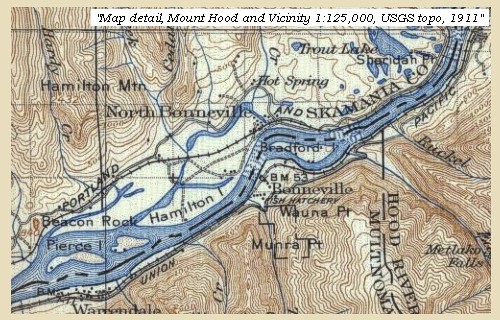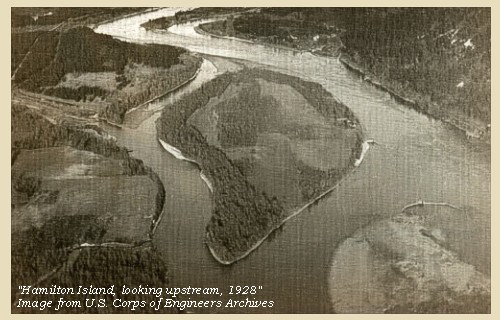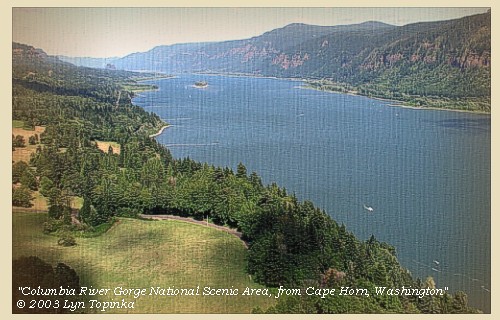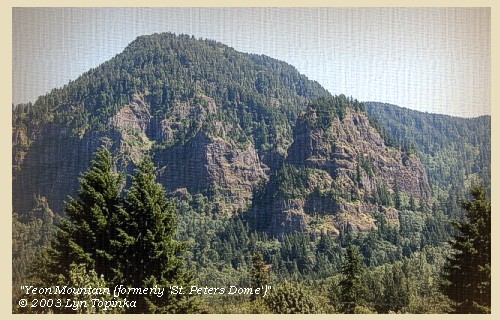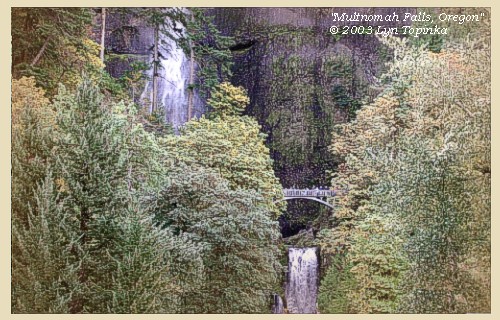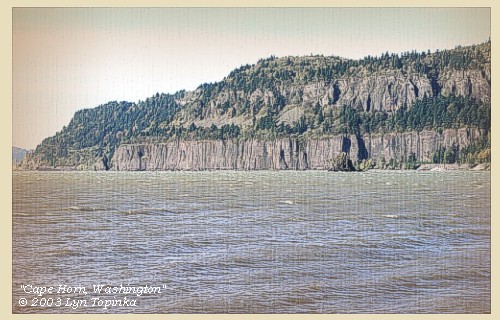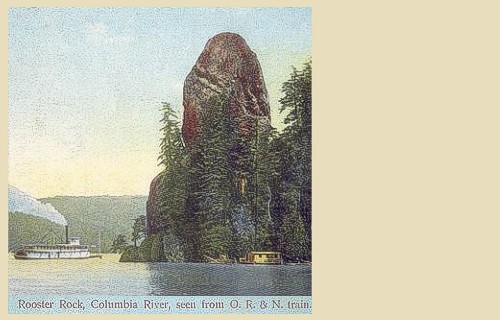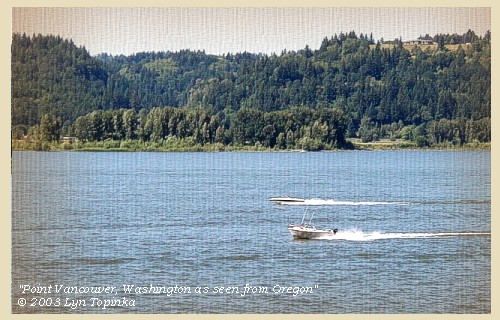The Volcanoes of
Lewis and Clark
Lewis and Clark
|
November 2, 1805 Columbia River Gorge - Beacon Rock to Rooster Rock |
|
Home
The Volcanoes of Lewis and Clark Map of the Journey Volcanoes, Basalt Plateaus, Major Rivers, etc. The Volcanoes Mount Adams, Mount Hood, Mount Jefferson, Mount Rainier, and Mount St. Helens CALENDAR of the Journey October 1805 to June 1806 Along the Journey Pacific Northwest Maps - Columbia River, Volcanoes, Flood Basalts, Missoula Floods, Geology, etc. The Corps of Discovery The Journey of Lewis and Clark About the Reference Materials The Journals, Biddle/Allen, DeVoto, Gass, Moulton, Topo Maps, and others USGS Lewis and Clark Links Links to USGS Websites highlighting the Lewis and Clark Journey Resources Publications Referenced and Websites Visited |
PREVIOUS
November 1 Columbia River Gorge, Cascade Locks to Bonneville - The Portage |
November 2
Columbia River Gorge, Beacon Rock to Rooster Rock Rapids below Bradford Island, Hamilton Island, Pierce NWR, Beacon Rock and Beacon Rock State Park, Franz Lake NWR, Columbia Gorge National Scenic Area, Yeon Mountain (St. Peter's Dome), Multnomah Falls, Lava Flows and Waterfalls, Phoca Rock, Cape Horn, Rooster Rock and Rooster Rock State Park, Point Vancouver |
CONTINUE
November 3 Columbia River Heading West, Rooster Rock to Columbia River Slough |
|
To the Pacific - November 1805
Columbia River Gorge - Beacon Rock to Rooster Rock |
| Lewis and Clark's camp of November 1, 1805 was on the Washington side of the Columbia River, downstream of today's Bonneville Dam, near the towns of Fort Rains and North Bonneville. |
| Saturday, November 2, 1805 |
| We now examined the rapid below more particularly [and a mile and a half downstream of Bradford Island], and the danger appearing to be too great for the loaded canoes, all those who could not swim were sent with the baggage by land. The canoes then passed safely, and were reloaded; at the foot of the rapid we took a meridian altitude of 59? 45' 45" |
| Just as we were setting out seven squaws arrived across the portage loaded with dried fish and bear-grass, neatly packed in bundles, and soon after four Indians came down the rapid in a large canoe. After breakfasting we left our camp at one o'clock, passed the upper point of an island [Hamilton Island] which is separated from the right shore by a narrow channel, through which in high tides the water passes. But at present it contains no running water, and a creek which falls into it from the mountains on the right [Hamilton Creek], is in the same dry condition, though it has the marks of discharging immense torrents at some seasons. The island [Hamilton Island] thus made is three miles in length and about one in width; its situation is high and open, the land rich, and at this time covered with grass and a great number of strawberry vines, from which we gave it the name of Strawberry island. In several places we observed that the Indians had been digging for roots, and indeed the whole island bears every appearance of having been at some period in a state of cultivation. |
| On the left side of the river the low ground is narrow and open: the rapid which we have just passed [below Bonneville Dam] is the last of all the descents of the Columbia. At this place the first tide-water commences, and the river in consequence widened immediately below the rapid. As we descended, we reached at the distance of one mile from the rapid a creek under a bluff on the left [Tanner Creek], at three miles is the lower point of Strawberry island [Hamilton Island]. To this immediately succeed three small islands covered with wood [two islands today, Pierce and Ives Islands]; in the meadow to the right [Hardy Creek and today's Pierce National Wildlife Refuge], |
|
|
|
Pierce National Wildlife Refuge:
Pierce National Wildlife Refuge consists of 336 acres of river bottomland habitat with riparian areas, wetlands, grasslands, and hardwoods. The refuge provides habitat for Canada geese, a variety of other waterfowl, and numerous other wildlife species. Hardy Creek supports one of the last remaining chum salmon runs in the lower Columbia River drainage. The south end of the refuge can be viewed from the Beacon Rock trail. -- U.S. Fish and Wildlife Service Website, 2003 |
| and at some distance from the hills, stands a high perpendicular rock, about eight hundred feet high, and four hundred yards round the base; this we called the Beacon rock. [Beacon Rock] |
| "... 5 miles to a timbered bottom on the Lard. Side, passed the Lowr. point of Strawbery Isd. at 3 miles, a Isd Covd with wood below on Stard. Side a remarkable high rock on Stard. Side about 800 feet high & 400 yds round, the 'Beaten' Rock. The mountains and bottoms thickly timbered with Pine Spruce Cotton and a kind of maple ..." [Clark, November 2, 1805, first draft] |
| Just below is an Indian village of nine houses, situated between two small creeks [Woodward Creek and Duncan Creek]. At this village the river widens to nearly a mile in extent, the low grounds too become wider, and they as well as the mountains on each side are covered with pine, spruce-pine, cottonwood, a species of ash, and some alder. [today this area includes the Franz National Wildlife Refuge] |
|
|
|
Franz Lake National Wildlife Refuge:
Franz Lake National Wildlife Refuge contains more than 500 acres of river bottomland and upland riparian habitat with numerous springs, seeps and creeks, grasslands, hardwood and upland forests. Franz Lake is one of the few remaining natural wetlands in the Columbia River Gorge. The refuge provides critical habitat for tundra swans and other waterfowl and year-round habititat for a variety of wildlife species. Visitors can view the refuge from a scenic overlook on Washington State Highway 14. -- U.S. Fish and Wildlife Service Website, 2003 |
| After being so long accustomed to the dreary nakedness of the country above, the change is as grateful to the eye, as it is useful in supplying us with fuel. [Lewis and Clark are within today's Columbia River Gorge National Scenic Area] |
| Yeon Mountain is a lava flow features which make the Columbia River Gorge spectacular. Yeon Mountain is located on the Oregon side of the Columbia River. |
| Numerous waterfalls are within the Columbia Gorge National Scenic area. |
| Four miles from the village is a point of land on the right, where the hills become lower, but are still thickly timbered. The river is now about two miles wide, the current smooth and gentle, and the effect of the tide has been sensible since leaving the rapid. Six miles lower is a rock rising from the middle of the river to the height of one hundred feet, and about eighty yards at its base [Phoca Rock, the Biddle/Allen version says "eighty yards at its base" whereas the original journals have "eighty feet", see quotation below]. |
| "... passed a rock at 10 miles in the middle of the river this rock is 100 feet high & 80 feet Diameter ..." [Clark, November 2, 1805, first draft] |
| "... at 17 miles passed a rock near the middle of the river, about 100 feet high and 80 feet Diameter, ..." [Clark, November 2, 1805] |
| The Biddle/Allen version does not mention Cape Horn, however the first draft of Captain Clark's journal mentions the Cape Horn area as a "Stard. point of rocks on a high clift of black rocks" |
| We continued six miles further, and halted for the night under a high projecting rock [Rooster Rock] on the left side of the river |
| opposite the point of a large meadow [Point Vancouver]. |
| The mountains, which from the great shoot to this place are high, rugged, and thickly covered with timber chiefly of the pine species, here leave the river on each side; the river becomes two and a half miles in width, and the low grounds are extensive and well supplied with wood. The Indians whom we left at the portage passed us, on their way down the river, and seven others who were descending in a canoe for the purpose of trading below, encamped with us. We had made from the foot of the great shoot twenty-nine miles today. The ebbtide rose at our camp about nine inches, the flood must rise much higher. We saw great numbers of water-fowl, such as swan, geese, ducks of various kinds, gulls, plover, and the white and gray brant, of which last we killed eighteen. |
| "... we encamped under a high projecting rock on the Lard. Side, here the mountains leave the river on each Side, which from the great Shute to this place is high and rugid; thickly covered with timber principalley of the Pine Species. The bottoms below appear extensive and thickly covered with wood. river here about 2 1/2 miles wide. ..." [Clark, November 2, 1805] |
|
|
|
The Camp - November 2, 1805:
Lewis and Clark's camp of November 2, 1805, was on the Oregon side of the Columbia River near Rooster Rock. |
| Home | Previous | Continue |
If you have questions or comments please contact: GS-CVO-WEB@usgs.gov
June/July 2004, Lyn Topinka
The Volcanoes of Lewis and Clark Home Page | CVO Home Page


